
Another Green World is the third solo studio album by Brian Eno, released by Island Records on 14 November 1975. The album marked a transition from the rock-based music of Eno's previous releases toward the minimalist instrumentals of his late 1970s ambient work. Only five of its fourteen tracks feature vocals, a contrast with his previous vocal albums.
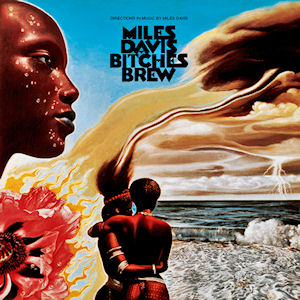
Bitches Brew is a studio album by the American jazz trumpeter, composer, and bandleader Miles Davis. It was recorded from August 19 to 21, 1969, at Columbia's Studio B in New York City and released on March 30, 1970, by Columbia Records. It marked his continuing experimentation with electric instruments that he had featured on his previous record, the critically acclaimed In a Silent Way (1969). With these instruments, such as the electric piano and guitar, Davis departed from traditional jazz rhythms in favor of loose, rock-influenced arrangements based on improvisation. The final tracks were edited and pieced together by producer Teo Macero.
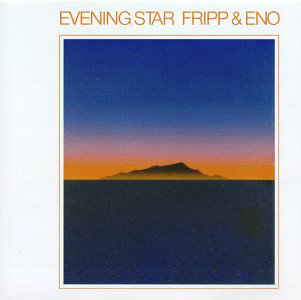
Evening Star is the second studio album by British musicians Robert Fripp and Brian Eno. It was recorded from 1974 to 1975 and released in December 1975 by Island Records.
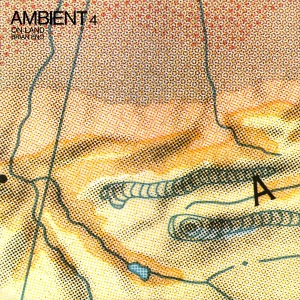
Ambient 4: On Land is the eighth solo studio album by Brian Eno, released in March 1982 by EG Records. It was the final edition in Eno's ambient series, which began in 1978 with the release of Ambient 1: Music for Airports. The album was released to critical acclaim, and is, along with the rest of the ambient series, recognised as a landmark album in the history of the ambient music genre.

Here Come the Warm Jets is the debut solo album by Brian Eno, released on Island Records on 8 February 1974. It was recorded and produced by Eno following his departure from Roxy Music, and blends glam and pop stylings with avant-garde approaches. The album features numerous guests, including several of Eno's former Roxy Music bandmates along with members of Hawkwind, Matching Mole, Pink Fairies, Sharks, Sweetfeed, and King Crimson. Eno employed unusual directions and production methods to coax unexpected results from the musicians.

Fresh is the sixth album by American funk band Sly and the Family Stone, released by Epic/CBS Records in June 1973. Written and produced by Sly Stone over two years, Fresh has been described as a lighter and more accessible take on the dense, drum machine-driven sound of its landmark 1971 predecessor There's a Riot Goin' On. It was the band's final album to reach the US Top 10, entering the Billboard Album Chart on June 30, and their last of three consecutive number-one albums on the R&B chart. In 2003, the album was ranked number 186 on Rolling Stone magazine's list of the 500 greatest albums of all time.

In a Silent Way is a studio album by the American jazz trumpeter, composer, and bandleader Miles Davis, released on July 30, 1969, on Columbia Records. Produced by Teo Macero, the album was recorded in one session date on February 18, 1969, at CBS 30th Street Studio in New York City. Macero edited and arranged Davis's recordings from the session to produce the album. Marking the beginning of his "electric" period, In a Silent Way has been regarded by music writers as Davis's first fusion recording, following a stylistic shift toward the genre in his previous records and live performances.

Jack Johnson is a studio album and soundtrack by the American jazz trumpeter, composer, and bandleader Miles Davis. It was released on February 24, 1971, by Columbia Records.
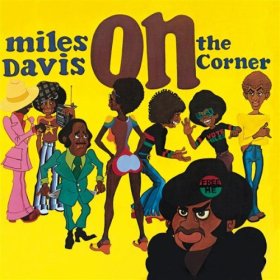
On the Corner is a studio album by the American jazz trumpeter, bandleader, and composer Miles Davis. It was recorded in June and July 1972 and released on October 11 of the same year by Columbia Records. The album continued Davis's exploration of jazz fusion, and explicitly drew on the influence of funk musicians Sly Stone and James Brown, the experimental music of Karlheinz Stockhausen, the free jazz of Ornette Coleman, and the work of collaborator Paul Buckmaster.

Big Fun is an album by American jazz trumpeter Miles Davis. It was released by Columbia Records on April 19, 1974, and compiled recordings Davis had made in sessions between 1969 and 1972. It was advertised as a new album with "four new Miles Davis compositions" One of three Davis albums released in 1974 and largely ignored, it was reissued on August 1, 2000, by Columbia and Legacy Records with additional material, which led to a critical reevaluation.

Stranded is the third album by English rock band Roxy Music, released in 1973 by Island Records. Stranded was the first Roxy Music album on which Bryan Ferry was not the sole songwriter, with multi-instrumentalist Andy Mackay and guitarist Phil Manzanera also making songwriting contributions. It is also their first album with keyboardist/violinist Eddie Jobson and bassist John Gustafson, who replaced Brian Eno and John Porter, respectively, after their departures following the release of their previous album For Your Pleasure.
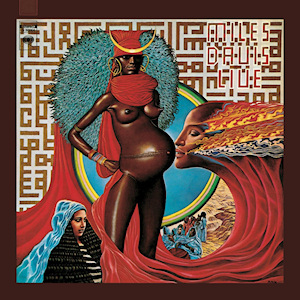
Live-Evil is an album of both live and studio recordings by the American jazz musician Miles Davis. Parts of the album featured music from Davis' concert at the Cellar Door in 1970, which producer Teo Macero subsequently edited and pieced together in the studio. They were performed as lengthy, dense jams in the jazz-rock style, while the studio recordings consisted mostly of renditions of Hermeto Pascoal compositions. The album was originally released on November 17, 1971.
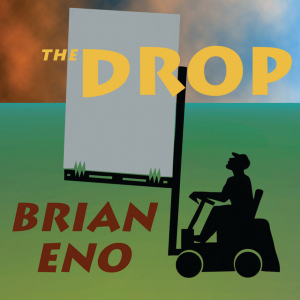
The Drop is the fourteenth solo studio album by Brian Eno, released on 7 July 1997 through All Saints Records. The album continues in the same style as much of his work of the period exploring impressionistic, ambient instrumental soundscapes rather than more conventional songwriting. The 2014 reissue includes the 77 Million Paintings album as a bonus disc and edits the track "Iced World" from its original 32 minutes down to 18 minutes – the same duration on both vinyl and CD.

Circle in the Round is a 1979 compilation album by jazz musician Miles Davis. It compiled outtakes from sessions across fifteen years of Davis's career that, with one exception, had been previously unreleased. All of its tracks have since been made available on album reissues and box sets.

In Concert is a live double album by the American jazz musician Miles Davis. It was recorded in 1972 at the Philharmonic Hall in New York City. Columbia Records' original release did not credit any personnel, recording date, or track listing, apart from the inner liner listing the two titles "Foot Fooler" and "Slickaphonics."
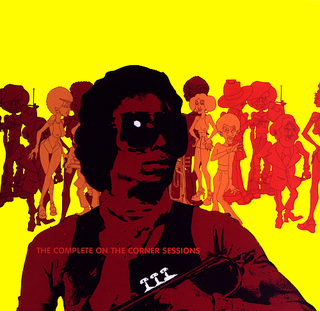
The Complete On the Corner Sessions is a posthumous box set by American jazz musician Miles Davis, released in the US on September 25, 2007, by Columbia Records and in the UK on September 29 on Legacy Recordings. Like other Davis box sets, the included material is taken from a wider chronology of sessions than the dates which actually produced the titular album. The Complete On the Corner Sessions compiles material from 1972 through 1975 which, due to lineup changes Davis made throughout the era, features over two dozen musicians.

Water Babies is a compilation album by American jazz trumpeter Miles Davis. It compiled music Davis recorded in studio sessions with his quintet in 1967 and 1968, including outtakes from his 1968 album Nefertiti and recordings that foreshadowed his direction on In a Silent Way (1969), while covering styles such as jazz fusion and post-bop. Water Babies was released by Columbia Records in 1976 after Davis had (temporarily) retired.

Betty Davis is the eponymous debut studio album by American funk singer Betty Davis, released through Just Sunshine Records in 1973. The album was produced by Greg Errico and features contributions from a number of noted musicians such as Neal Schon, Merl Saunders, Sylvester, Larry Graham, Pete Sears, and The Pointer Sisters.

Panthalassa: The Music of Miles Davis 1969–1974 is a remix album by Miles Davis, released on February 16, 1998, by Sony Records. It contains compositions from prior albums, including In a Silent Way (1969), On the Corner (1972), and Get Up With It (1974), remixed by Bill Laswell; it is subtitled "Reconstruction and Mix Translation by Bill Laswell". The album was composed as a dark, continuous tone poem divided by four sections of Davis' jazz fusion recordings. Panthalassa received generally positive reviews from music critics and sold well, charting at number four on the Billboard Top Jazz Albums.

Bitches Brew Live is a live album by Miles Davis. The album was released in February 2011 and contains material compiled from two concert performances. Most of the songs on the album originally appeared on Bitches Brew. The first three tracks were recorded at the Newport Jazz Festival in July 1969, nine months before the release of Bitches Brew, while the rest of the album was recorded at 1970 Isle of Wight Festival. The three cuts from Newport—"Miles Runs the Voodoo Down", "Sanctuary", and "It's About That Time/The Theme"—were previously unreleased at the time and have since been reissued on Miles Davis at Newport 1955–1975: The Bootleg Series Vol. 4. This recording marks the first known time that "Miles Runs the Voodoo Down" was professionally recorded. The final six cuts appeared on the "Miles Electric" DVD in video form and the audio portion was included in the box set Miles Davis: The Complete Columbia Album Collection. A seventeen-minute segment appeared under the title "Call It Anything" on the First Great Rock Festivals of the Seventies: Isle of Wight/Atlanta Pop Festival compilation album in 1971.




















